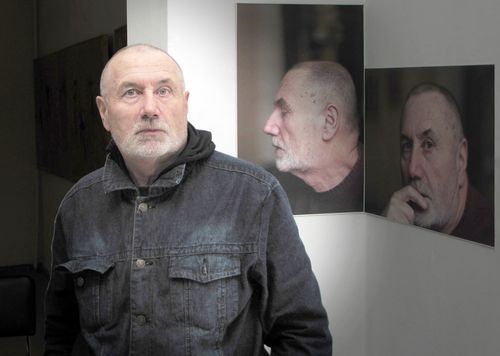Ritual dances
Kost Borysiuk has presented a fantastic painting spectacle at the Gallery of Arts in Lutsk
From the clown to the king, the man is defenseless against the other sex’s beauty and unique plasticity. His natural instincts compel the man to start performing trance-inducing, ritual dances, and, unlike other mammals, fishes, birds, and reptiles, he is wont to display his artificial colorful decorations, aping all and every of our fellow creatures if it helps him to impress the woman, to make himself look as the only possible partner in her eyes. This is typical of human civilization throughout its existence. Are these ritual dances still relevant, though?
This topic has become the background for the Volyn artist Kost Borysiuk’s solo exhibition, ongoing at the Gallery of Arts in Lutsk. I was honored with an invitation to this fantastic painting spectacle. On entering the premises, I immediately felt myself immersed in warm pastel colors of the artist’s canvasses that looked like an immense array of bright decorations worn by ritual dancers. Cats playfully caressed female midriffs, foxes looked around cunningly, and that familiar restless champion of fertility, the rabbit seemed to be jumping out of the painting into the gallery’s halls.
According to the artist, his project “Ritual Dances” is a fruit of five years’ labor. He was absorbed by the task to the point of unwittingly becoming a part of the action. Of course, he, too, is portrayed as a whole-hearted adorer of his queen in the paintings. Well, to be more specific, he dances as a cockerel before being approved as a lover, and then becomes a male pigeon, faithful member of the pair.
Every canvas features its own layout, and each painting performs its own mission in the spectacle. Female figures enjoy the commanding positions, dominating verticals, horizontals and diagonals throughout the project. An especially attractive composition depicts women placed in a bowl filled with bright orange color.
Some scenes show women remaining alone in the cycle of life, as they often do in everyday reality; these paintings elicit a strong melancholic feeling. To some extent, painting compositions involving active male movements and color are violating the chastity of female nature, so it is only appropriate to blindfold female figures on these paintings, and the master has done exactly that in a very delicate manner. The ritual dance mystery is very active and unpredictable, so the conventional painting format was often preventing the artist from unfolding the action as he saw fit. Thus, he turned to diptychs, triptychs and even larger formats, totally unlimited, but all of them comply naturally with the laws of composition and the dance finds its completion. Paintings seem to be moving further into the exhibition hall.
Some paintings’ subject matters are magic dances of calendar rites, but they also depict women who are immersed in Chopin’s beautiful waltzes. The artist’s overarching idea is a sufficient justification for this interweaving of epochs, since the human movement, having spawned the ritual dances, is a reaffirmation and perpetuation of life itself. Borysiuk’s artworks are a noble hymn to love that calls for extraordinarily sensitive perception on the part of this exhibition’s visitors. The exposition has been organized in an amazingly professional manner. In some cases, the artist’s choice of color and layout draws the visitors deeper into the vibrations of his paintings, while other canvasses calm the visitors allowing them to perceive the paintings more actively. The exhibition starts with a woman in the natural environment depicted through a variety of emerald tints, looking like a flower in a meadow. It ends with a painting of plowed field featuring a range of tonal colors, reflecting the earth’s spring awakening.
So, we have the solution for our dilemma, as the ritual dance is a natural prelude to the coming revival of life.
Director of the Art Museum of Lutsk Zoia Navrotska confessed to us she would like to have a separate museum dedicated to the exhibition, to leave it intact. It is a right call, as this exhibition displays a stage of the master’s highly aesthetic and spiritual maturity, and the state must honor his achievements adequately.
Выпуск газеты №:
№60, (2013)Section
Time Out





